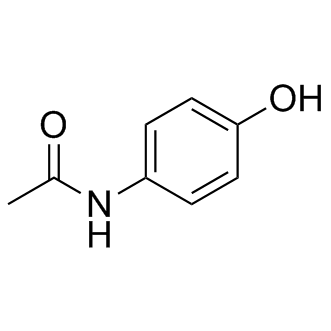
Acetaminophen
CAS No. 103-90-2
Acetaminophen( Paracetamol | 4-Acetamidophenol | APAP )
Catalog No. M10198 CAS No. 103-90-2
A well-known analgesic and antipyretic agent that selectively inhibits COX activities in the brain.
Purity : >98% (HPLC)
 COA
COA
 Datasheet
Datasheet
 HNMR
HNMR
 HPLC
HPLC
 MSDS
MSDS
 Handing Instructions
Handing Instructions
| Size | Price / USD | Stock | Quantity |
| 500MG | 37 | In Stock |


|
| 1G | Get Quote | In Stock |


|
Biological Information
-
Product NameAcetaminophen
-
NoteResearch use only, not for human use.
-
Brief DescriptionA well-known analgesic and antipyretic agent that selectively inhibits COX activities in the brain.
-
DescriptionA well-known analgesic and antipyretic agent that selectively inhibits COX activities in the brain; might modulate the endogenous cannabinoid system in the brain through paracetamol's metabolite, AM404; is typically used for mild to moderate pain.Pain Approved(In Vitro):n vitro, acetaminophen elicites a 4.4-fold selectivity toward COX-2 inhibition (IC50 113.7 μM for COX-1; IC50 25.8 μM for COX-2). Following oral administration of the drug, maximal ex vivo inhibitions are 56% (COX-1) and 83% (COX-2). Acetaminophen plasma concentrations remaine above the in vitro IC50 for COX-2 for at least 5 h postadministration. Ex vivo IC50 values (COX-1: 105.2 μM; COX-2: 26.3 μM) of acetaminophen compared favorably with its in vitro IC50 values. In contrast to previous concepts, acetaminophen inhibited COX-2 by more than 80%, i.e., to a degree comparable to nonsteroidal antiinflammatory drugs (NSAIDs) and selective COX-2 inhibitors. However, a >95% COX-1 blockade relevant for suppression of platelet function is not achieved. MTT assay shows that Acetaminophen (APAP) in a dose of 50 mM significantly (p<0.001) reduces cell viability to 61.5±6.65%. Interestingly, the significant (p<0.01) increase in cell viability to 79.7±2.47% is observed in the Acetaminophen/HV110 co-treated cells, compared to Acetaminophen treated cells.(In Vivo):Administering Acetaminophen (250 mg/kg, orally) to the mice causes significant (p<0.001) liver damage and necrosis of cells as evidenced by the elevated serum hepatic enzymes alanine aminotransferase (ALT), aminotransferase (AST), alkaline phosphatase (ALP), and gamma-glutamyl transferase (γGT) compared with normal group. Conversely, effects of pretreatment with different doses of citral (125, 250, and 500 mg/kg) exhibited a significant (p<0.05) decrease in serum activities of ALT (91.79%, 93.07%, and 95.61%, resp.), AST (93.40%, 91.89%, and 96.52%, resp.), ALP (39.29%, 37.07%, and 59.80%, resp.), and γGT (92.83%, 91.59%, and 93.0%, resp.), when compared to the Acetaminophen group. Similar results were found in pretreatment with SLM on the activity of ALT (95.90%), AST (95.03%), ALP (70.52%), and γGT (92.69%).
-
In VitroIn vitro, acetaminophen elicites a 4.4-fold selectivity toward COX-2 inhibition (IC50 113.7 μM for COX-1; IC50 25.8 μM for COX-2). Following oral administration of the drug, maximal ex vivo inhibitions are 56% (COX-1) and 83% (COX-2). Acetaminophen plasma concentrations remaine above the in vitro IC50 for COX-2 for at least 5 h postadministration. Ex vivo IC50 values (COX-1: 105.2 μM; COX-2: 26.3 μM) of acetaminophen compared favorably with its in vitro IC50 values. In contrast to previous concepts, acetaminophen inhibited COX-2 by more than 80%, i.e., to a degree comparable to nonsteroidal antiinflammatory drugs (NSAIDs) and selective COX-2 inhibitors. However, a >95% COX-1 blockade relevant for suppression of platelet function is not achieved. MTT assay shows that Acetaminophen (APAP) in a dose of 50 mM significantly (p<0.001) reduces cell viability to 61.5±6.65%. Interestingly, the significant (p<0.01) increase in cell viability to 79.7±2.47% is observed in the Acetaminophen/HV110 co-treated cells, compared to Acetaminophen treated cells.
-
In Vivo——
-
SynonymsParacetamol | 4-Acetamidophenol | APAP
-
PathwayChromatin/Epigenetic
-
TargetCOX
-
RecptorCOX-1|COX-2
-
Research AreaNeurological Disease
-
IndicationPain
Chemical Information
-
CAS Number103-90-2
-
Formula Weight151.1626
-
Molecular FormulaC8H9NO2
-
Purity>98% (HPLC)
-
Solubility10 mM in DMSO
-
SMILESCC(NC1=CC=C(O)C=C1)=O
-
Chemical NameAcetamide, N-(4-hydroxyphenyl)-
Shipping & Storage Information
-
Storage(-20℃)
-
ShippingWith Ice Pack
-
Stability≥ 2 years
Reference
1. Ghanem CI, et al. Pharmacol Res. 2016 Jul;109:119-31.
2. Huseinovic A, et al. PLoS One. 2017 Mar 14;12(3):e0173573.
3. Rashid U, et al. BMC Complement Altern Med. 2016 Nov 9;16(1):449.
molnova catalog



related products
-
Sulfinpyrazone
A uricosuric drug that is used to reduce the serum urate levels in gout therapy.
-
6-methoxy Naphthalen...
6-methoxy Naphthalene Acetic Acid is a competitive inhibitor of COX(Ki values of 21 and 19 μM for ovine COX-1 and -2 respectively).
-
Flunixin meglumin
Flunixin Meglumin is a potent inhibitor of the enzyme cyclooxygenase used as analgesic agent with anti-inflammatory and antipyretic activity.



 Cart
Cart
 sales@molnova.com
sales@molnova.com


